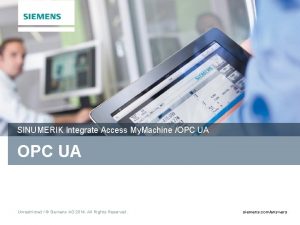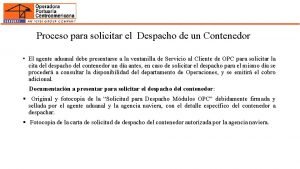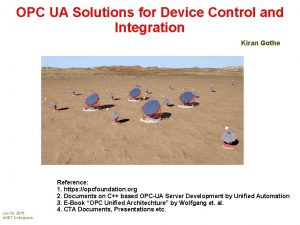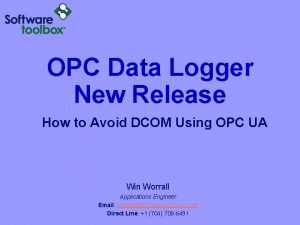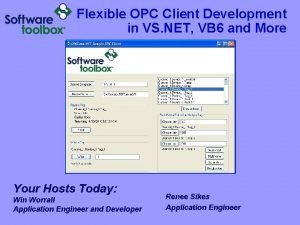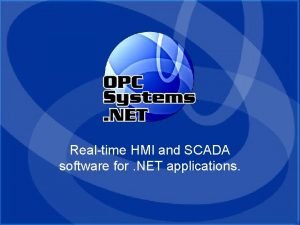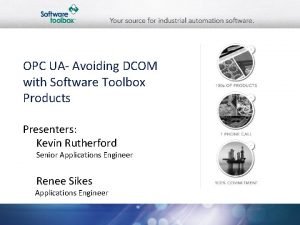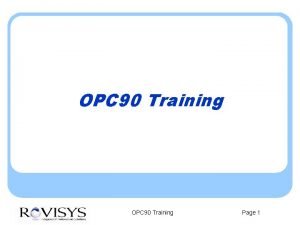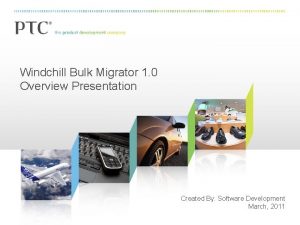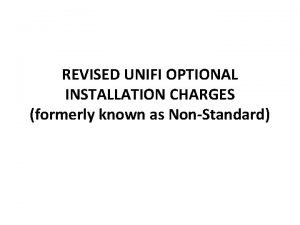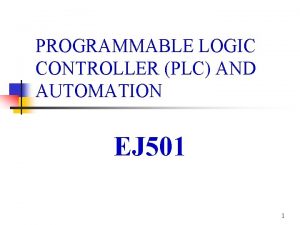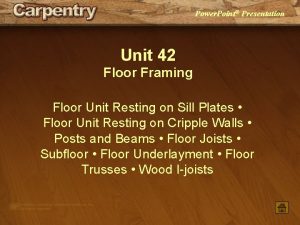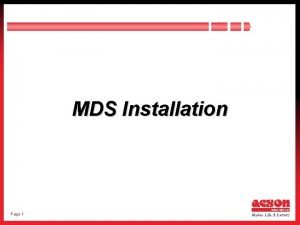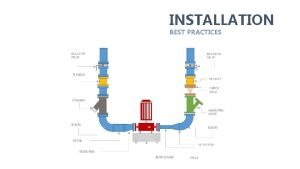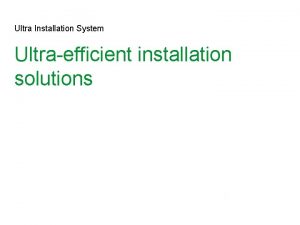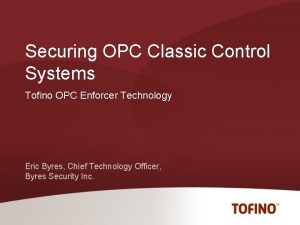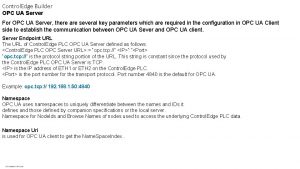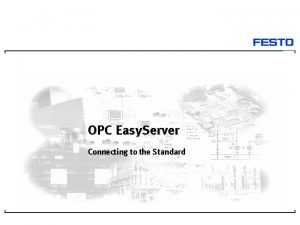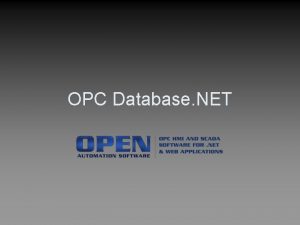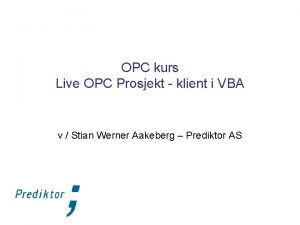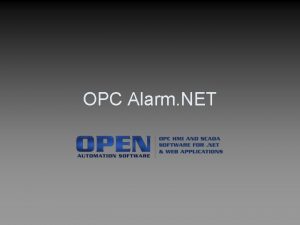OPC 90 Training Page 1 Installation l OPC




























![View Status Bar State of Database Shadowing [] [] Off [] [] Good []< View Status Bar State of Database Shadowing [] [] Off [] [] Good []<](https://slidetodoc.com/presentation_image_h/ec8f68ba425f78628d931b21e62a6edc/image-29.jpg)




















- Slides: 49

OPC 90 Training Page 1

Installation l OPC 90 licensing is accomplished with a USB key dongle shipped with the software. • • l The official OPC 90 installation program is found on the CD and called: • l Install the USB key after completing the software installation. The cost to replace lost or stolen keys is the purchase of another license, so locate in a secure place. “Setup OPC 90 Server Version 6. 1 Build 1. exe” Install the software while logged into an administrator account. OPC 90 Training Page 2

Installation l Confirm successful installation by running OPC 90 Training Page 3

Installation l l Confirm successful installation by looking at OPC 90 help about dialog. Successful installation is confirmed when the four digit serial number of the USB key is seen in this dialog. USB Key Serial Number OPC 90 Training Page 4

Menu Items Use “File” to: • Open a database • Save a database • Import a database • Export a database Use “Edit” to setup: • Ports (COM port settings) • Engineering unit names • Text messages • Red tag users • SOE point names • Program priority • Configuration shadowing • Error detection Use “Add” to add new: • Devices (CIU connection) • Groups (of plant tags) • Blocks (Bailey data types) Use “View” to enable / disable: • Monitor mode • Program status bar • Startup in runtime • Run as a service OPC 90 Training Use “Utilities” to run: • Service Manager • DCOM Configurator • View program logs Use “Help” to: • View program “about” dialog • Call up detailed program help Page 5

Toolbar Items Create new database Open existing database Save current database Show Help About Future use Add a new device Future use Add a new group Add a new block Run service manager Run DCOM Configurator OPC 90 Training Future use View a log file Page 6

File Menu Items l l “New” and “Open” database will not be allowed when OPC clients are attached or currently operating in runtime (communicating with DCS). Remember to “Save” anytime a change has been made! Comma Separated Variable (CSV) files can be used to import a database. Export a current database to a CSV file to view it in Excel and make bulk changes. OPC 90 Training Page 7

Add Menu Items l l l Add a “New Device” to setup a communication link with the ABB Bailey CIU. Groups can be added under a device. And are used to organize a collection of blocks. Groups are not necessary but if used become part of the OPC tag name. Blocks are added directly under a Device or a group. Blocks define a tag name, type of DCS data being received and address within the DCS. OPC 90 Training Page 8

Adding a New Device Give the device OPC 90 For The applications Setup a. Simulation default max can For name. When the participate most out device The communication block OPC 90 that applications, is name useful parameters are #insetting starts the purely when ABB up, these reserves parameters. read engineering are Bailey it will miscellaneous ideal only, Give take that DCS for the The many awhile an just time “supervisory device OPC 90 “scheme” about CIU synchronization. settings before aindices solution all description data defines applications. control do for not actually and the awrite need to Select single seeing output help Note begins lock” to be CIU, to be becomes part the that option types changing of system changed. the received redundant of prevents CIU OPC blocks. type data type The tag from (Infi any is values names Most channels name. automatically 90 the type or applications DCS. by of. Network ofeach the towrite that The OPC option determined to CIU 90). length don’t the clients. remember or Note are DCS use redundant ofself Simulation for time and those from explanatory. Network what will isoccurring. block based CIUs. be CIU can shown 90 types on is The be systems, being Also This the for primary when since size when the includes used. the looking there Device ofand they the database are types purpose at block of selected secondary the which nodes and device is tuning to determines in input asource detailed the ports properties and block system operator can data message how types. bewhile to must serial long the writes When also OPC 90 DCS. box it(COM takes such be will AOL This defined is ports) appear to as inand establish setting set theor DOL using point runtime explaining SCSI should block in changes, the addresses. mode “Define be inputs CIU. further left of etc. The as simulation operation Nodes…” what When is. OPC unless they using quality isare of the button. selected, COM Participating tags ports, Device reported match in communication time tothe (communicating synchronization baud OPC otherwise intended rate clients does withis to with needed. occur the selected occurs accomplish. the CIU but DCS). when setting the here inputs either during using to“PC Edit this the. Get output startup | Ports DCS block menu time period. Time” or “PCtypes Get and are automatically Set DCS item. Time” changed. is selected. OPC 90 Training Page 9

Adding a New Group l Add a “New Group” to organize a collection of blocks. • • Groups can be a name of an area in a plant or maybe types of blocks. Groups are intended for organization of the database but not required. Groups become part of the OPC tag name when used. Groups are not to be confused with OPC groups declared automatically by any OPC client that connects with OPC 90 Training Page 10

Adding a New Block l Add a “New Block” to define a tag name, tag type and address within the ABB Bailey DCS. • • Block name must be unique with respect to all other blocks within the current tree level. Block name can be any combination of characters except periods. It’s best to stick with alpha-numeric names for compatibility with most OPC client software. Block name is part of OPC tag name. Block address (ABB Bailey ring, node, module and block number) must be unique with respect to all other blocks (except POLL and SPEC blocks) in the database. OPC 90 Training Page 11

Adding a New Block l This is the common dialog used to add all OPC 90 block types to the database. • • It dynamically enables the appropriate fields to be filled in based on the selected block type. The name becomes part of the OPC tag name. The description is optional but useful to help identify the tag purpose. The addressing information links the block to a specific location in the ABB Bailey DCS. OPC 90 Training Page 12

Import Block Types Supported l l l As the name implies, import block types are used to receive data from the ABB Bailey system. Supervisory control writes to the DCS are supported by these blocks. • For example writes such as set point, output, mode to the STN block. All of these blocks (except BLK, MUXCIU, POLL and SPEC) receive the data via the standard ABB Bailey exception reporting mechanism. OPC 90 Training Page 13

Export Block Types Supported l l l As the name implies, export block types are used to source exception reported data to the ABB Bailey system. These blocks allow OPC clients to source the data associated with these point types to the ABB Bailey system. The CIU becomes the source of the data. Most applications of OPC 90 do not utilize these point types. • They are mostly used to generate links between the ABB Bailey system and an external control platform such as a PLC or another DCS. OPC 90 Training Page 14

Adding a New Block l l l Here is an example of our FI 101 block shown online receiving data. OPC tag CIU. FI 101. OUT is the analog value of this block. Notice all of the other available sub tags (i. e. HI_LIM, LO_LIM, etc). OPC 90 Training Page 15

Edit Menu Items l Use this menu item to: • • • Delete the currently selected tree element, Define COM port settings, Define engineering units, Define text messages, Define red tag users, Define SOE point names, Look at properties of the currently selected tree element, Set program execution priority, Define configuration shadowing, Enable error detection logging. OPC 90 Training Page 16

Edit COM Port Settings Match CIU baud rate COM port to edit l Match CIU parity No flow control is best Remember to use this dialog to setup the COM port associated with a Device block! • Should always be 8 1 or 2 but usually 1 OPC 90 Training These values override COM port settings defined under Windows Control Panel. Page 17

Edit Engineering Units l l Click on E. U. code to edit Assigns names to ABB Bailey engineering unit codes. All analog blocks receiving exception report data have an OPC tag called. EU_TEXT getting its string value from these settings. Type name for selected code Click here to set the name to the code OPC 90 Training Page 18

Edit Text Messages l Click on message number to edit Use this dialog to setup text strings associated with message numbers reported by Text Selector (F. C. 151) blocks. Or enter message number to edit Enter text string for the message Click here to set message number to text string OPC 90 Training Page 19

Edit Red Tag Users l Click on red tag entry to edit Use this dialog to setup red tag user codes and names. These codes and names are used with those blocks that support the ABB Bailey red tag function. Assign a unique red tag user number (0 – 65535) Type in the user name Click here to set this user number / name OPC 90 Training Page 20

Edit SOE Point Names l Click on point number to edit Use this dialog to setup SOE point names. These point names are used for the SOE logs generated by the SOE block. The SOE block receives the SOE data from ABB Bailey F. C. s 99 & 243. Type in the point name Click here to set this point name Select the SOE point set to edit (1 -4) sets OPC 90 Training Page 21

Edit Properties l l Calls up the properties dialog for the currently selected entry in the tree. Also available by right clicking on that tree entry and selecting properties. OPC 90 Training Page 22

Edit Priority Click on desired priority level l Defines priority the OPC 90 process will run at. Can be changed on the fly. Normal is fine for most applications. l Change to High on heavily loaded PCs. l OPC 90 Training Click here to set the selected priority Page 23

Edit Configuration Shadowing Type in other PC name Click here to enable l l l Configuration shadowing can be used when running redundant OPC 90 Servers. Redundant OPC 90 s must be running on networked PCs. If running OPC 90 as service, it must be under a privileged user account (not the system account). OPC 90 Training Page 24

Edit Error Detection Enable the error detection log Enable dead client monitoring technology Customize OPC Get. Status() return code Turn on OPC function tracing Select OPC functions to be traced l l l Error detection is used to find really tough OPC client / server problems. Most applications don’t need to be concerned with this dialog. Error detection logs are stored in C: Program FilesOPC 90 ServerLog OPC 90 Training Page 25

General OPC 90 Logs Right click on the Device block Click on the specific log to enable or disable l l l General logs are useful for finding CIU communication and other runtime errors. These logs are stored in C: Program FilesOPC 90 ServerLog Its ok to run all the time with “Log CIU Errors” enabled but the others should only be enabled when specifically trying to solve a problem. Otherwise the log files tend to consume significant disk space. OPC 90 Training Page 26

View Menu Items l Use this menu item to enable / disable: • • Monitor mode, View of program status bar, Startup in Runtime, Running as a service. OPC 90 Training Page 27

View Monitor Click here to enable / disable monitor mode Real time value from the DCS l l Monitor mode displays the runtime values being received from the DCS. Enabling monitor mode puts OPC 90 into runtime mode (if it is not already in it). Disabling monitor mode takes OPC 90 out of runtime mode unless OPC clients are attached. Exiting OPC 90 while in monitor mode leaves it running but with a hidden window. OPC 90 Training Page 28
![View Status Bar State of Database Shadowing Off Good View Status Bar State of Database Shadowing [] [] Off [] [] Good []<](https://slidetodoc.com/presentation_image_h/ec8f68ba425f78628d931b21e62a6edc/image-29.jpg)
View Status Bar State of Database Shadowing [] [] Off [] [] Good []< >[] Bad Total OPC clients attached Total OPC groups for all OPC clients l State of selected Tree item Total OPC tags for all OPC clients OPC update rate for all OPC tags Runtime state Indicates running as “User”, “Client” or “Service” Status bar displays overview information about current program operation OPC 90 Training Page 29

View Startup in Runtime Click here to enable / disable Startup in Runtime mode l l Startup in Runtime sets OPC 90 to automatically start its communication logic when the program is first executed. This occurs even when no OPC clients attach. It causes the database to be established with the Bailey interface and made ready for access prior to any OPC client attaching to OPC 90. if startup in runtime is enabled and monitor mode enabled and than disabled when there are no outstanding OPC clients attached, the runtime mode of operation is stopped. OPC 90 Training Page 30

View Run as Service Click here to enable / disable Run as Service OPC 90 Training Page 31

Utilities Menu Items l Use this menu item to run the utilities: • • • Service Manager, DCOM Configuration, View My Logs. OPC 90 Training Page 32

Utilities Service Manager Click here to run Windows Service Manager l Windows Service Manager • • Start / Stop OPC 90, Change account OPC 90 runs under. OPC 90 Training Page 33

Utilities DCOM Configuration Click here to run Windows DCOM Configuration l Windows DCOM Configuration • • • Configure My Computer DCOM settings, Configure OPC 90 DCOM settings, See OPC 90 user manual for detailed DCOM setup information. OPC 90 Training Page 34

Utilities View My Logs Click here to select a log file to view l Uses Windows notepad to view logs • Select error detection or general log files. • Example shows general log file with Log CIU Errors, Send, Receive enabled. OPC 90 Training Page 35

Help Menu Items l Help menu item: • • Displays About OPC 90 Server, Calls up detailed program help. OPC 90 Training Page 36

Help About OPC 90 Server Click here to see About OPC 90 Server l l l License type, version & release date, Detailed license information, Encouragement of the day, Available disk and memory, Rovi. Sys copyright information. OPC 90 Training Page 37

Help Contents Click here to see detailed OPC 90 help l l l Use the help system to learn more information about OPC 90. Consult the Blocks book for detailed information about each block type and the wealth of data made available. OPC Client Access book provides detailed OPC DCOM setup. OPC 90 Training Page 38

OPC 90 Faceplates Right click on any block and select Faceplate… l l Block type specific faceplate is displayed showing pertinent information for the block. All data shown is available as OPC tags. OPC 90 Training Page 39

Example of the Device Block Faceplate l Shows useful communication status information with the ABB Bailey CIU. OPC 90 Training Page 40

Example of the Station (STN) Block Faceplate l l Shows ABB Bailey STN block PID controller data. Be careful, supervisory control writes can be issued from this faceplate! OPC 90 Training Page 41

Example of the BLK Block Faceplate l l OPC 90 Training This block allows display, tuning and modification of ABB Bailey controller configuration logic. It’s a very powerful block. Configurations can even be saved and restored with this block. Again all data to accomplish this activity is available via OPC tags. Page 42

OPC 90 Supports Tag Writes Right click on a tag to be written and select Write… l Enter the value to be written and click on the Write button. OPC 90 Training Page 43

OPC Test Client l l l Installation of OPC 90 includes a sample test OPC client called Data. Spy can be used to test OPC connections with OPC 90 Data. Spy can be used to monitor plant tag values available from OPC 90 Training Page 44

Data. Spy Click here to turn on output window Output window displays useful OPC messages OPC 90 Training Page 45

Data. Spy Click here to connect with OPC 90 Server Output window shows successful connection. Browse failed is normal. That’s how a client finds top of tree. OPC 90 Training Page 46

Data. Spy Browse to a tag value, right click and pick monitor. OPC 90 Training Page 47

Data. Spy Click on Data Monitor OPC 90 Training Real time data value can be watched Page 48

OPC 90 Training Finished! l l l Thanks for taking this OPC 90 training course. Remember OPC 90 help contains detailed information regarding the subjects taught in this course. We appreciate the confidence placed in Rovi. Sys by your use of our OPC 90 Server product! OPC 90 Training Page 49
 Apa titling
Apa titling Training binder cover page
Training binder cover page Pengertian routing sheet
Pengertian routing sheet Sinumerik integrate
Sinumerik integrate Plan atraque opc
Plan atraque opc Opc ua device integration
Opc ua device integration Opc data logger
Opc data logger Berry
Berry Opc for ado
Opc for ado Opc tunneller
Opc tunneller Opc systems
Opc systems Ole db to opc
Ole db to opc Nwca opc
Nwca opc Opc-34712
Opc-34712 Nwca optimal performance calculator
Nwca optimal performance calculator Opc real-time data to streaminsight
Opc real-time data to streaminsight Opc vs pvt ltd
Opc vs pvt ltd Opc pharma
Opc pharma Types of grade of concrete
Types of grade of concrete Datahub opc bridge
Datahub opc bridge Opc championnat live
Opc championnat live Opc 3
Opc 3 Top server opc
Top server opc Opc data spy
Opc data spy Windchill bulk migrator installation and usage guide
Windchill bulk migrator installation and usage guide Air clutch system
Air clutch system Armored cables manufacturers
Armored cables manufacturers Tema id
Tema id Technisonic avionics installation
Technisonic avionics installation Solar summit county
Solar summit county Sonarqube vs sonatype
Sonarqube vs sonatype Unifi standard installation
Unifi standard installation Smoke detector mounting tape
Smoke detector mounting tape Plc
Plc Squash block installation framing
Squash block installation framing Permastore factories
Permastore factories Nm interlock indigent fund
Nm interlock indigent fund National electrical installation standards
National electrical installation standards Meter installation/removal
Meter installation/removal Installation refnet
Installation refnet Spectrum self install rescue
Spectrum self install rescue Installation solceller örnsköldsvik
Installation solceller örnsköldsvik Localizer antenna array
Localizer antenna array Hvad er knx
Hvad er knx Gree versati 3
Gree versati 3 Gps lockbox installation instructions
Gps lockbox installation instructions Fusioncompute installation step by step
Fusioncompute installation step by step Fso installation
Fso installation Winfeed installation key
Winfeed installation key Where is the deadman on a fiberglass tank
Where is the deadman on a fiberglass tank



